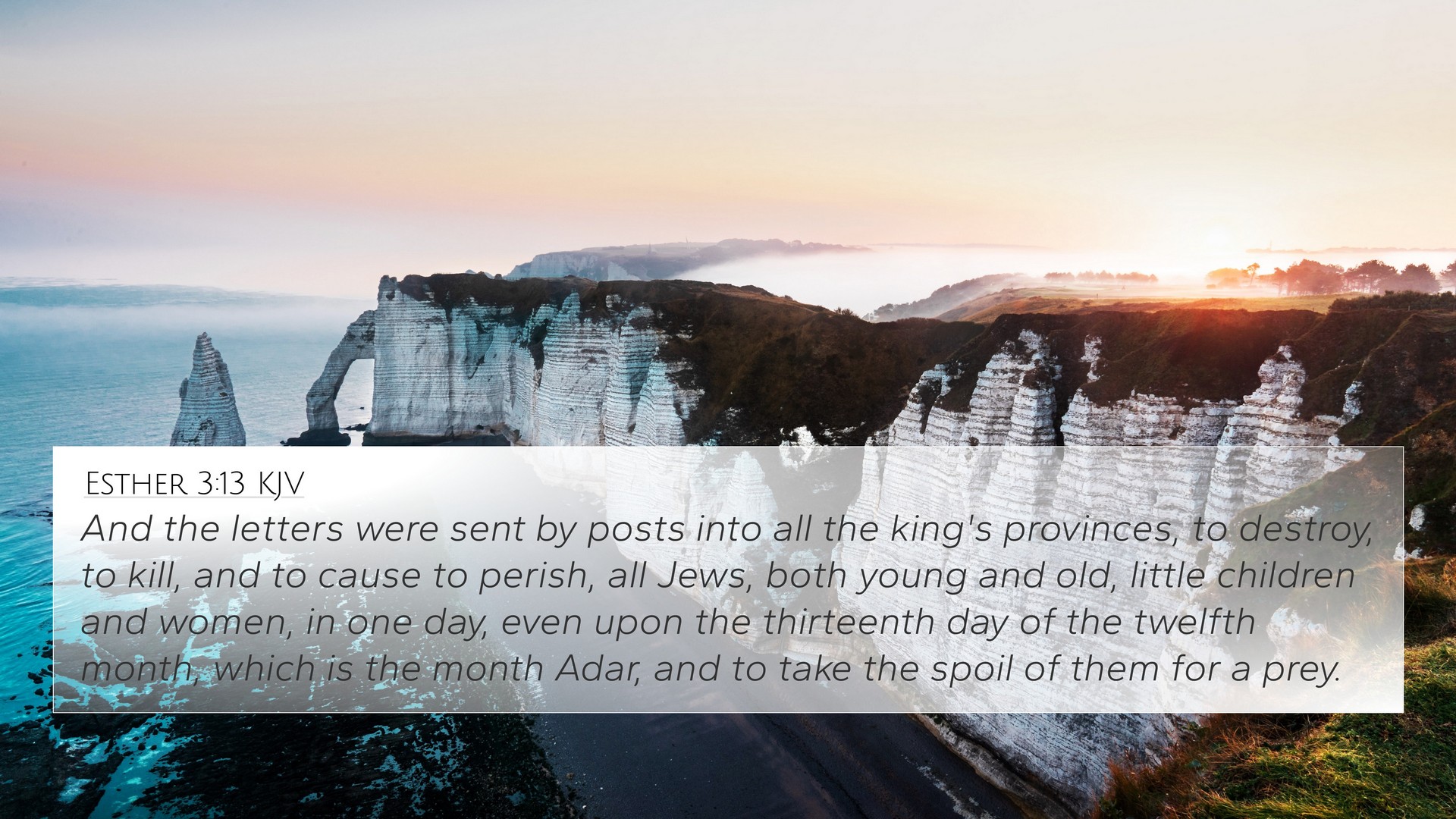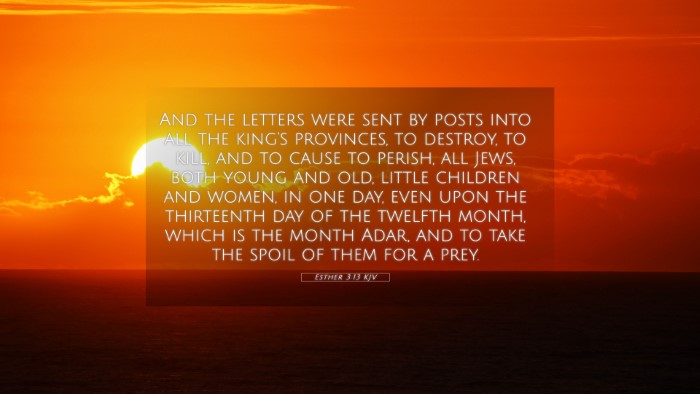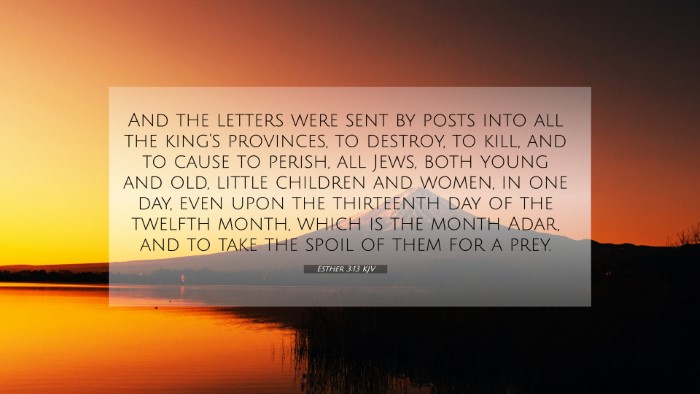Old Testament
Genesis Exodus Leviticus Numbers Deuteronomy Joshua Judges Ruth 1 Samuel 2 Samuel 1 Kings 2 Kings 1 Chronicles 2 Chronicles Ezra Nehemiah Esther Job Psalms Proverbs Ecclesiastes Song of Solomon Isaiah Jeremiah Lamentations Ezekiel Daniel Hosea Joel Amos Obadiah Jonah Micah Nahum Habakkuk Zephaniah Haggai Zechariah MalachiEsther 3:13 Similar Verses
Esther 3:13 Cross References
And the letters were sent by posts into all the king's provinces, to destroy, to kill, and to cause to perish, all Jews, both young and old, little children and women, in one day, even upon the thirteenth day of the twelfth month, which is the month Adar, and to take the spoil of them for a prey.
Uncover the Rich Themes and Topics of This Bible Verse
Listed below are the Bible themes associated with Esther 3:13. We invite you to explore each theme to gain deeper insights into the Scriptures.
Esther 3:13 Cross Reference Verses
This section features a detailed cross-reference designed to enrich your understanding of the Scriptures. Below, you will find carefully selected verses that echo the themes and teachings related to Esther 3:13 KJV. Click on any image to explore detailed analyses of related Bible verses and uncover deeper theological insights.
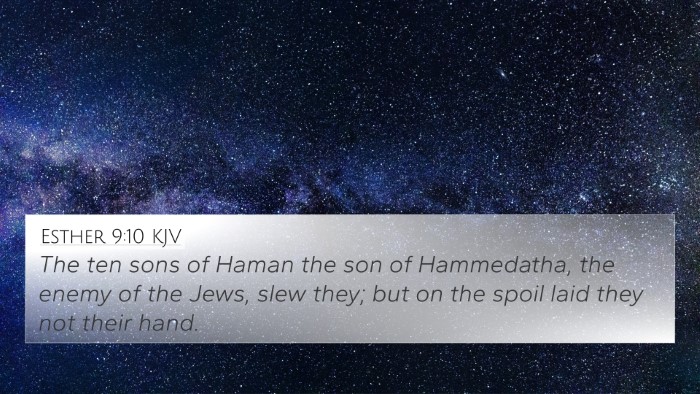
Esther 9:10 (KJV) »
The ten sons of Haman the son of Hammedatha, the enemy of the Jews, slew they; but on the spoil laid they not their hand.

2 Chronicles 30:6 (KJV) »
So the posts went with the letters from the king and his princes throughout all Israel and Judah, and according to the commandment of the king, saying, Ye children of Israel, turn again unto the LORD God of Abraham, Isaac, and Israel, and he will return to the remnant of you, that are escaped out of the hand of the kings of Assyria.
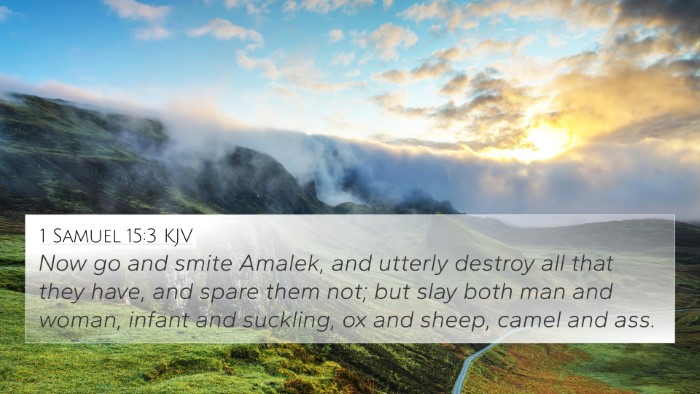
1 Samuel 15:3 (KJV) »
Now go and smite Amalek, and utterly destroy all that they have, and spare them not; but slay both man and woman, infant and suckling, ox and sheep, camel and ass.
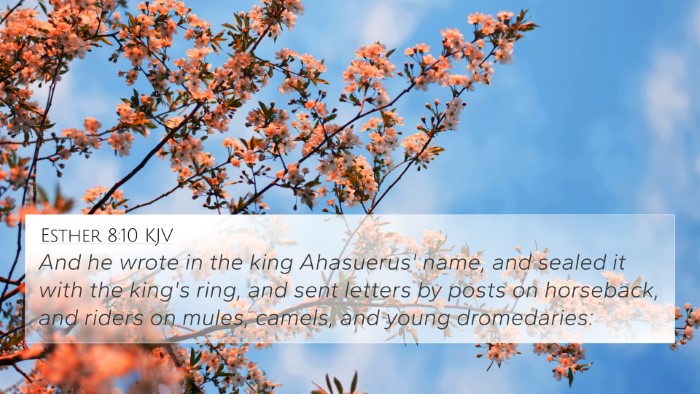
Esther 8:10 (KJV) »
And he wrote in the king Ahasuerus' name, and sealed it with the king's ring, and sent letters by posts on horseback, and riders on mules, camels, and young dromedaries:
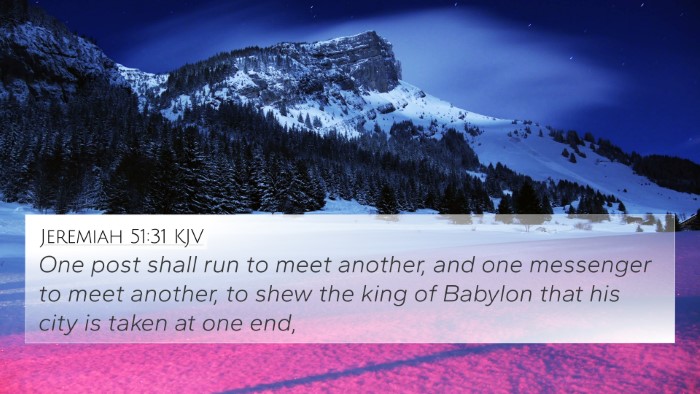
Jeremiah 51:31 (KJV) »
One post shall run to meet another, and one messenger to meet another, to shew the king of Babylon that his city is taken at one end,
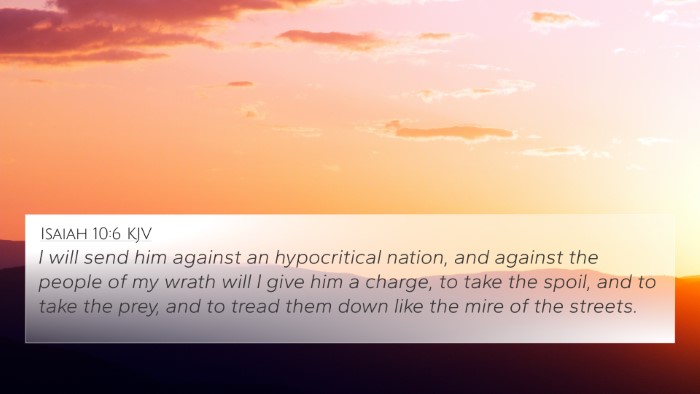
Isaiah 10:6 (KJV) »
I will send him against an hypocritical nation, and against the people of my wrath will I give him a charge, to take the spoil, and to take the prey, and to tread them down like the mire of the streets.
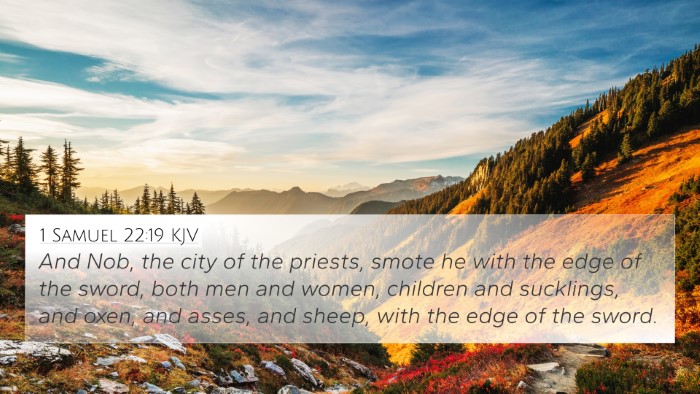
1 Samuel 22:19 (KJV) »
And Nob, the city of the priests, smote he with the edge of the sword, both men and women, children and sucklings, and oxen, and asses, and sheep, with the edge of the sword.

Esther 7:4 (KJV) »
For we are sold, I and my people, to be destroyed, to be slain, and to perish. But if we had been sold for bondmen and bondwomen, I had held my tongue, although the enemy could not countervail the king's damage.
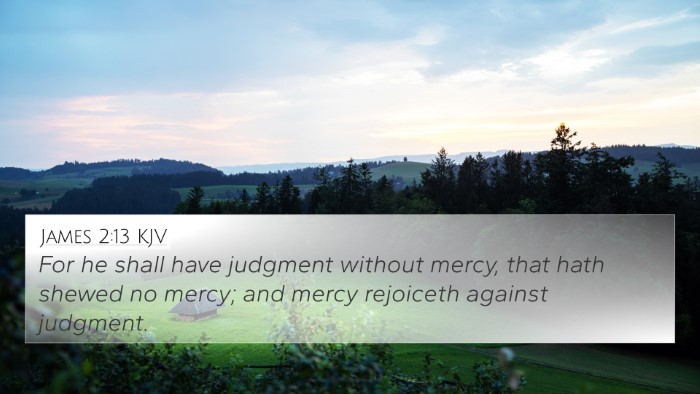
James 2:13 (KJV) »
For he shall have judgment without mercy, that hath shewed no mercy; and mercy rejoiceth against judgment.
Esther 3:13 Verse Analysis and Similar Verses
Understanding Esther 3:13
The verse Esther 3:13 states:
"And the letters were sent by posts into all the king's provinces, to destroy, to kill, and to cause to perish all Jews, both young and old, little children and women, in one day, even upon the thirteenth day of the twelfth month, which is the month Adar, and to take the spoil of them for a prey."
This verse marks a pivotal moment in the Book of Esther, revealing the decree by Haman to annihilate the Jewish people. The seriousness of the situation and its implications for the Jewish nation are at the forefront of this passage.
Summary of Insights
Drawing from public domain commentaries, we can extract several layers of meaning associated with this verse:
- Divine Sovereignty: As highlighted by Matthew Henry, this event underscores God's control over human affairs, even when evil appears to triumph.
- The Role of Evil: Albert Barnes notes the malevolence of Haman, offering insight into the nature of sin and the persecution of God's people.
- Judgment and Deliverance: Adam Clarke draws attention to the themes of judgment that precede divine deliverance, establishing a pattern seen throughout scripture.
- Courage of Esther: This event catalyzes Esther's eventual intervention, showcasing her bravery and the role of individuals in God’s plan.
- Historical Context: The decree reflects historical hostilities against the Jews, serving to remind the reader of a broader narrative of Jewish suffering and survival.
- Foreshadowing Deliverance: The mention of a specific date—the thirteenth day of the twelfth month—foreshadows the great reversal that will ensue, offering hope amidst despair.
- Cross-References to Other Texts: This incident connects to various other scriptures where God intervenes in moments of crisis.
Bible Verse Cross-References
As we explore connections between Bible verses, we find multiple cross-references that enhance our understanding of Esther 3:13:
- Exodus 17:14-16: God’s promise to blot out the memory of Amalek; Haman is descended from the Amalekites.
- Psalms 37:12-13: The wicked plotting against the just, leading to God's eventual justice.
- Esther 8:1-17: The reversal of the decree and the triumph of the Jewish people.
- Isaiah 54:17: "No weapon that is formed against thee shall prosper," contextualizing God’s protection over His people.
- Matthew 2:16: King Herod's decree to kill infants echoes the malevolence seen in Haman’s plot.
- Revelation 12:17: The ongoing conflict between the dragon (representing evil) and the rest of the woman's seed (God's people).
- Romans 8:31: If God is for us, who can be against us? This highlights divine support amid persecution.
Scriptural Cross-Referencing
This verse serves not only as a standalone teaching but as a critical link in an inter-Biblical dialogue reflecting on themes of persecution, divine justice, and protection of God's people.
Tools for Bible Cross-Referencing
For those looking to delve deeper into cross-referencing, several tools can aid in connecting this verse with its themes:
- Bible Concordance: A tool that lists words and phrases to find related verses.
- Bible Cross-Reference Guide: Organized systems that help in finding thematic connections.
- Cross-Reference Bible Study: Techniques for exploring relations among different scripts.
- Bible Reference Resources: Materials like dictionaries and atlases that offer insights into culture and context.
Comparative Bible Verse Analysis
By engaging in a comparative study of passages related to Esther 3:13, one can identify the recurring motifs of oppression and deliverance throughout scripture.
How to Use Bible Cross-References
Understanding how to navigate these references is essential:
- Start with a specific verse and identify keywords.
- Utilize a concordance to find scripture that links back to those keywords.
- Examine the context of each referenced verse to draw parallel themes.
Identifying Connections Between Old and New Testament
Esther’s story, while rooted in the Old Testament, has implications seen in the New Testament’s teachings on suffering and divine intervention. Recognizing these links enriches the reader's understanding.
Cross-Referencing Themes in the Bible
Several themes emerge through cross-referencing:
- Faith Amidst Trials: Seen in both Esther and the experiences of early Christians.
- God’s Protection of His People: A continuous theme throughout scripture from Exodus to Revelation.
- Biblical Justice: The narrative of Esther ultimately reveals God’s justice and faithfulness in the face of evil.
Conclusion
Esther 3:13 serves as a profound reminder of the spiritual battles at play and the need for vigilance and faith in God's sovereignty. By utilizing tools for cross-referencing and deepening our engagement with scripture, we uncover a richer understanding of the interconnected Biblical narrative that underlines God's unfailing commitment to His people.
